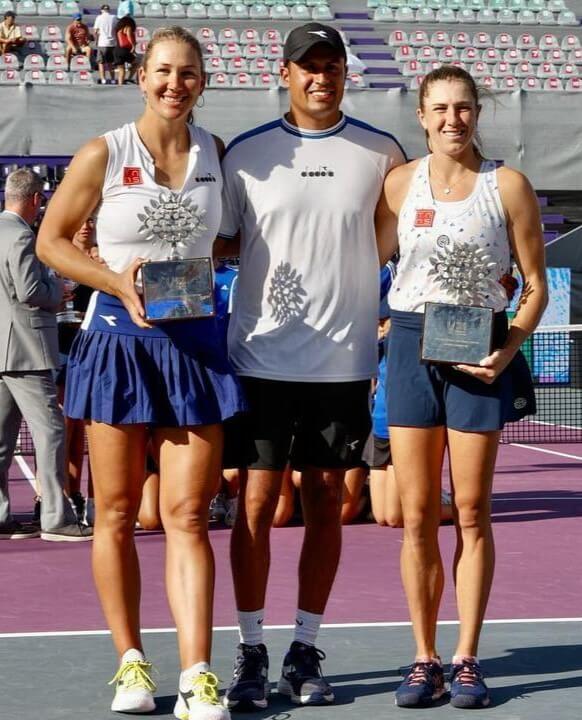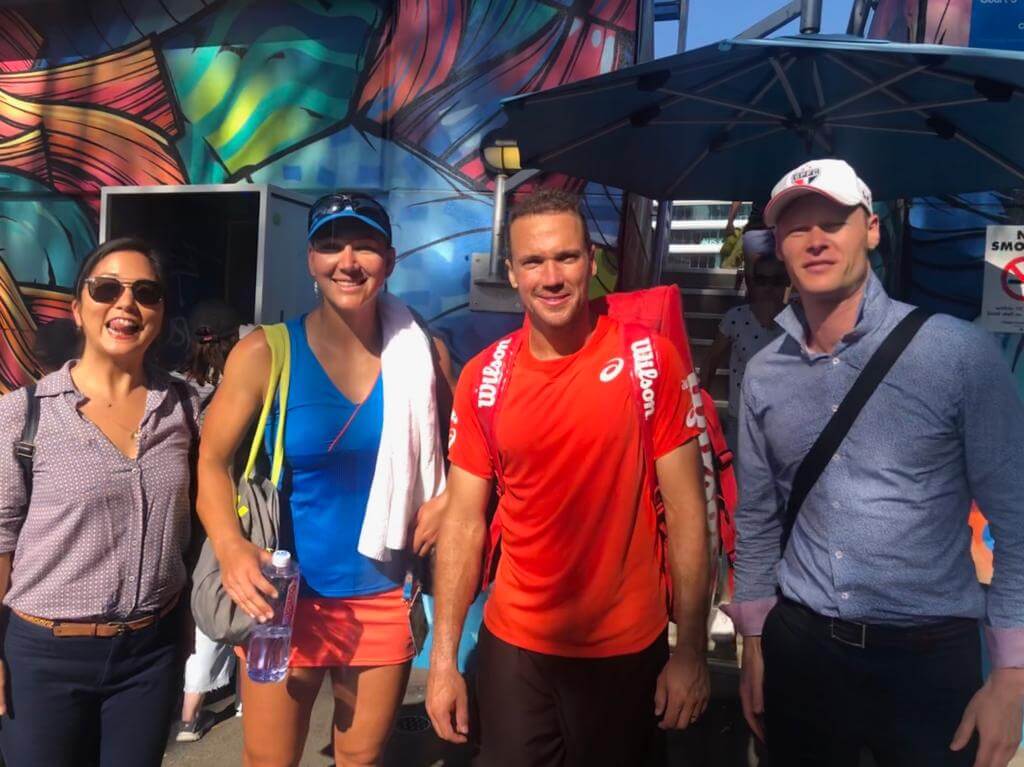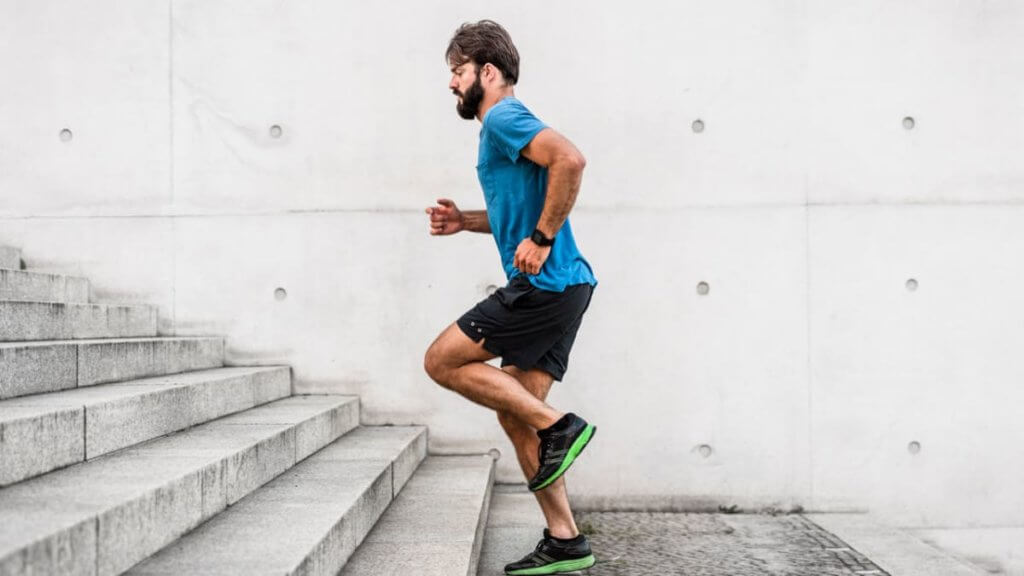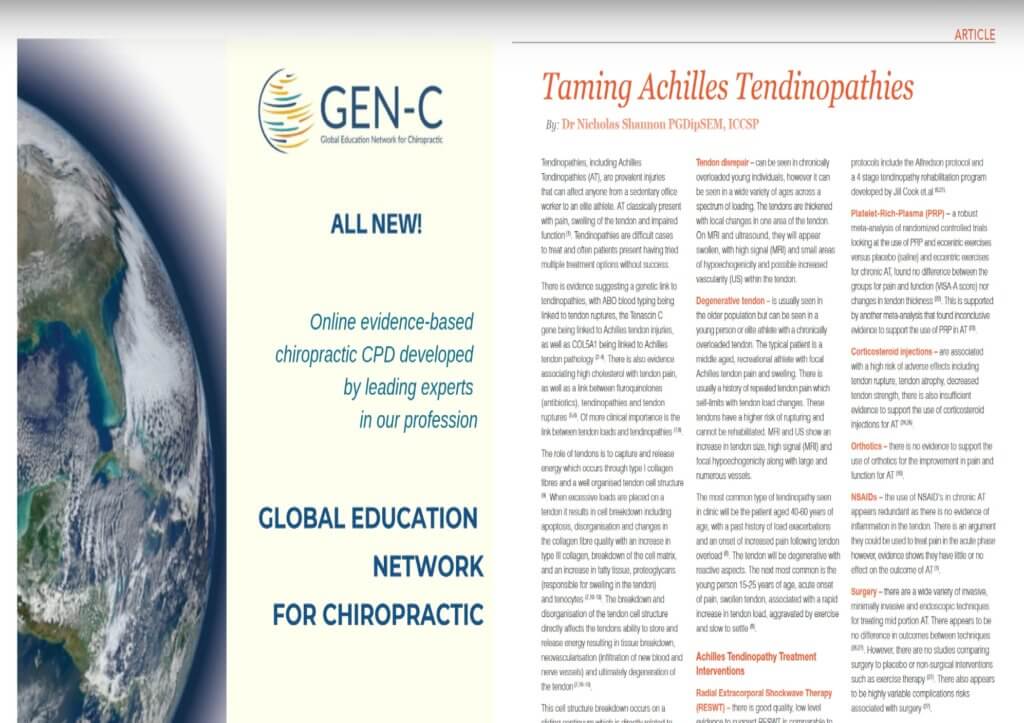Achilles Tendinopathies
Achilles tendon pain is a prevalent condition that is an extremely frustrating and challenging condition to treat for both patient and practitioner. Fortunately there is a strong and ever growing body of evidence that supports the use of heavy tendon load exercises in the treatment of tendinopathies, especially achilles tendinopathies (AT).
In September 2019, Melbourne city chiropractor Dr. Shannon published an article in the Chiropractic Australia, COCA News magazine examining AT and what the evidence currently tells us.
Taming Achilles Tendinopathies
By (Dr. Nicholas Shannon PGDipSEM, ICCSP)
Introduction
Tendinopathies, including Achilles tendinopathies (AT) are prevalent injuries that can affect anyone from a sedentary office worker to an elite athlete. AT classically present with pain, swelling of the tendon and impaired function (1). Tendinopathies are difficult cases to treat and often patients present having tried multiple treatment options without success.
There is evidence suggesting a genetic link to tendinopathies, with ABO blood typing being linked to tendon ruptures, the Tenascin C gene being linked to Achilles tendon injuries, as well as COL5A1 being linked to Achilles tendon pathology (2–4). There is also evidence associating high cholesterol with tendon pain, as well as a link between fluroquinolones (antibiotics), tendinopathies and tendon ruptures (5,6). Of more clinical importance is the link between tendon loads and tendinopathies (7,8).
The Role of Tendons
The role of tendons are to capture and release energy which occurs through type I collagen fibres and a well organised tendon cell structure (9). When excessive loads are placed on a tendon it results in cell breakdown including apoptosis, disorganisation and changes in the collagen fibre quality with an increase in type III collagen, break down of the cell matrix, and an increase in fatty tissue, proteoglycans (responsible for swelling in the tendon) and tenocytes (7,10–13). The break down and disorganisation of the tendon cell structure directly affects the tendons ability to store and release energy resulting in tissue breakdown, neovascularisation (infiltration of new blood and nerve vessels) and ultimately degeneration of the tendon (7,10–13).
This cell structure breakdown occurs on a sliding continuum which is directly related to tendon load, with a healthy tendon at one end and a degenerative tendon at the other (7). When there is continuous excessive tendon load, the mechanically compromised tendon slides down the continuum from a normal tendon, to a reactive tendon, into tendon disrepair, ending at a degenerative tendon (7,14). During this degenerative process there is no frank evidence of inflammation hence the terminology shift from tendonitis to tendinopathy (15). To learn more about the tendon continuum read through our additional blog on Achilles Tendinopathy.
Clinical Stages of Tendon Degradation
Clinically the 3 stages of tendon degradation present as follows (7):
Reactive tendinopathy – most commonly seen in acute overload, usually in the young population, with no prior history of tendon pain. On MR and ultrasound (US) the tendon will appear swollen with no signal change (MR) and diffuse hypoechogenicity (US).
Tendon disrepair – can be seen in chronically overloaded young individuals, however it can be seen in a wide variety of ages across a spectrum of loading. The tendons are thickened with local changes in one area of the tendon. On MR and US, they will appear swollen, with high signal (MR) and small areas of hypoechogenicity and possible increased vascularity (US) within the tendon.
Degenerative tendon – is usually seen in the older population but can be seen in a young person or elite athlete with a chronically overloaded tendon. The typical patient is a middle aged, recreational athlete with focal Achilles tendon pain and swelling. There is usually a history of repeated tendon pain which self-limits with tendon load changes. These tendons have a higher risk of rupturing and cannot be rehabilitated. MR and US show an increase in tendon size, high signal (MR) and focal hypoechogenicity along with large and numerous vessels.
The most common type of tendinopathy seen in clinic will be the patient aged 40-60 years of age, with a past history of load exacerbations and an onset of increased pain following tendon overload (8). The tendon will be degenerative with reactive aspects. The next most common is the young person 15-25 years of age, acute onset of pain, swollen tendon, associated with a rapid increase in tendon load, aggravated by exercise and slow to settle (8).
Achilles Tendinopathy Treatment Interventions
Radial Extracorporal Shockwave Therapy (RESWT) – there is good quality, low level evidence to suggest RESWT is comparable to eccentrics for pain at 4 months and is superior to wait and see for pain and disability at 4 months for mid portion AT, as well as being superior to eccentrics at 4 months for pain and disability for insertional AT (16). A meta-analysis of randomized controlled trials showed RESWT had a positive effect on pain and function in AT, however the study had high heterogeneity and used the QVAS (VISA-A is the gold standard) as the primary outcome measure (17).
Exercise Therapy – exercise therapy has been advocated for AT with evidence supporting improvements in pain and function in mid portion AT (8,18). Exercise therapy for AT typically consists of differing loading programs involving isometric, eccentric and concentric exercises. Currently there is no evidence to support one loading program over another with all programs resulting in improvements (19,20). Commonly used protocols include the Alfredson protocol and a 4 stage tendinopathy rehabilitation program developed by Jill Cook et.al (8,21).
Platelet-Rich-Plasma (PRP) – a robust meta analysis of randomized controlled trials looking at the use of PRP and eccentric exercises versus placebo (saline) and eccentric exercises for chronic AT, found no difference between the groups for pain and function (VISA-A score) nor changes in tendon thickness (22). This is supported by another meta analysis that found inconclusive evidence to support the use of PRP in AT (23).
Corticosteroid injections – are associated with a high risk of adverse effects including tendon rupture, tendon atrophy, decreased tendon strength, there is also insufficient evidence to support the use of corticosteroid injections for AT (24,25).
Orthotics – there is no evidence to support the use of orthotics for the improvement in pain and function for AT (18).
NSAIDs – the use of NSAID’s in chronic AT appears redundant as there is no evidence of inflammation in the tendon. There is an argument they could be used to treat pain in the acute phase however, evidence shows they have little or no effect on the outcome of AT (1).
Surgery – there are a wide variety of invasive, minimally invasive and endoscopic techniques for treating mid portion AT. There appears to be no difference in outcomes between techniques (26,27). However, there are no studies comparing surgery to placebo or non-surgical interventions such as exercise therapy (27). There also appears to be highly variable complications risks associated with surgery (27).
Conclusions on Achilles Tendinopathy
AT and tendinopathies are challenging for the clinician and patient. Tendinopathy treatment needs to be individualised and should focus on removing the “abusive” tendon load, correcting any malalignment and biomechanical problems, as well as utilizing exercise therapy to strengthen any deficient areas and to manage tendon pain and improve function. Shockwave therapy should be considered for those not responding solely to exercise therapy or used in addition to exercise therapy. Clinicians also need to manage the expectations of their patients, as tendinopathies can take several months and sometimes longer to rehabilitate (28). With exercise therapy being the primary treatment modality, chiropractors are well placed to be the first-choice clinician in the management of AT tendinopathies.
If you would like to read more about running related injuries which includes Achilles tendinopathy head over to our blog. With a wealth of knowledge and experience in treating tendinopathies Melbourne city sports chiropractor Dr. Shannon at the Shannon Clinic Melbourne Chiropractic and Sports Care are well placed to treat your tendon pain. Book an appointment today with chiropractor Dr. Shannon or remedial massage therapist Paula Pen at our Melbourne CBD chiropractic clinic which is centrally located on Collins Street in the Melbourne CBD opposite the Melbourne Town Hall.
References
- 1. Li H-Y, Hua Y-H. Achilles Tendinopathy: Current Concepts about the Basic Science and Clinical Treatments. BioMed Res Int. 2016 Nov 3;doi:2016:6492597.
- 2. Magra M, Maffulli N. Genetic aspects of tendinopathy. J Sci Med Sport. 2008 Jun;11(3):243–7.
- 3. Mokone GG, Gajjar M, September AV, Schwellnus MP, Greenberg J, Noakes TD, et al. The guanine-thymine dinucleotide repeat polymorphism within the tenascin-C gene is associated with achilles tendon injuries. Am J Sports Med. 2005 Jul;33(7):1016–21.
- 4. Mokone GG, Schwellnus MP, Noakes TD, Collins M. The COL5A1 gene and Achilles tendon pathology. Scand J Med Sci Sports. 2006 Feb;16(1):19–26.
- 5. Tilley BJ, Cook JL, Docking SI, Gaida JE. Is higher serum cholesterol associated with altered tendon structure or tendon pain? A systematic review. Br J Sports Med. 2015 Dec;49(23):1504–9.
- 6. Lewis T, Cook J. Fluoroquinolones and Tendinopathy: A Guide for Athletes and Sports Clinicians and a Systematic Review of the Literature. J Athl Train. 2014;49(3):422–7.
- 7. Cook JL, Purdam CR. Is tendon pathology a continuum? A pathology model to explain the clinical presentation of load-induced tendinopathy. Br J Sports Med. 2009 Jun 1;43(6):409–16.
- 8. Cook JL, Kahn K, Reiman MP. Why and How Exercise is the Best Treatment for Tendinopathy. Combined Sections Meeting of The American Physical Therapy Association 2016. 2016 Feb 17-20; Anaheim California USA.
- 9. Franchi M, Trirè A, Quaranta M, Orsini E, Ottani V. Collagen structure of tendon relates to function. ScientificWorldJournal. 2007 Mar 30;7:404–20.
- 10. Samiric T, Ilic MZ, Handley CJ. Characterisation of proteoglycans and their catabolic products in tendon and explant cultures of tendon. Matrix Biol J Int Soc Matrix Biol. 2004 May;23(2):127–40.
- 11. Danielson P, Alfredson H, Forsgren S. Distribution of general (PGP 9.5) and sensory (substance P/CGRP) innervations in the human patellar tendon. Knee Surg Sports Traumatol Arthrosc Off J ESSKA. 2006 Feb;14(2):125–32.
- 12. Yu JS, Popp JE, Kaeding CC, Lucas J. Correlation of MR imaging and pathologic findings in athletes undergoing surgery for chronic patellar tendinitis. AJR Am J Roentgenol. 1995 Jul;165(1):115–8.
- 13. Kraushaar BS, Nirschl RP. Tendinosis of the elbow (tennis elbow). Clinical features and findings of histological, immunohistochemical, and electron microscopy studies. J Bone Joint Surg Am. 1999 Feb;81(2):259–78.
- 14. Longo UG, Ronga M, Maffulli N. Achilles tendinopathy. Sports Med Arthrosc Rev. 2009 Jun;17(2):112–26.
- 15. Maffulli N, Khan KM, Puddu G. Overuse tendon conditions: time to change a confusing terminology. Arthrosc J Arthrosc Relat Surg Off Publ Arthrosc Assoc N Am Int Arthrosc Assoc. 1998 Dec;14(8):840–3.
- 16. Korakakis V, Whiteley R, Tzavara A, Malliaropoulos N. The effectiveness of extracorporeal shockwave therapy in common lower limb conditions: a systematic review including quantification of patient-rated pain reduction. Br J Sports Med. 2018 Mar 1;52(6):387–407.
- 17. Liao C-D, Tsauo J-Y, Chen H-C, Liou T-H. Efficacy of Extracorporeal Shock Wave Therapy for Lower-Limb Tendinopathy: A Meta-analysis of Randomized Controlled Trials. Am J Phys Med Rehabil. 2018 Sep;97(9):605.
- 18. Wilson F, Walshe M, O’Dwyer T, Bennett K, Mockler D, Bleakley C. Exercise, orthoses and splinting for treating Achilles tendinopathy: a systematic review with meta-analysis. Br J Sports Med. 2018 Dec 1;52(24):1564–74.
- 19. Habets B, Cingel R. Eccentric exercise training in chronic mid-portion Achilles tendinopathy: A systematic review on different protocols. Scand J Med Sci Sports. 2014 Apr 1;25.
- 20. Murphy M, Rio E, Chivers P, Debenham J, Docking S, Travers M, et al. The rate of improvement of pain and function in mid-portion Achilles tendinopathy with loading protocols: A Systematic Review and Meta-Analysis Protocol. Sports Med. 2018 Aug;48(8):1875-1891.
- 21. Plas A van der, Jonge S de, Vos RJ de, Heide HJL van der, Verhaar J a. N, Weir A, et al. A 5-year follow-up study of Alfredson’s heel-drop exercise programme in chronic midportion Achilles tendinopathy. Br J Sports Med. 2012 Mar 1;46(3):214–8.
- 22. Zhang Y-J, Xu S-Z, Gu P-C, Du J-Y, Cai Y-Z, Zhang C, et al. Is Platelet-rich Plasma Injection Effective for Chronic Achilles Tendinopathy? A Meta-analysis. Clin Orthop. 2018 Aug;476(8):1633–41.
- 23. Hussain N, Johal H, Bhandari M. An evidence-based evaluation on the use of platelet rich plasma in orthopedics – a review of the literature. SICOT-J. 2017 Oct 9;doi: 10.1051/sicotj/2017036.
- 24. Hart L. Corticosteroid and other injections in the management of tendinopathies: a review. Clin J Sport Med Off J Can Acad Sport Med. 2011 Nov;21(6):540–1.
- 25. Kearney RS, Parsons N, Metcalfe D, Costa ML. Injection therapies for Achilles tendinopathy. Cochrane Database Syst Rev. 2015 May 26;(5):CD010960.
- 26. Lohrer H, David S, Nauck T. Surgical treatment for achilles tendinopathy – a systematic review. BMC Musculoskelet Disord. 2016 10;17:207.
- 27. Baltes TPA, Zwiers R, Wiegerinck JI, van Dijk CN. Surgical treatment for midportion Achilles tendinopathy: a systematic review. Knee Surg Sports Traumatol Arthrosc. 2017;25(6):1817–38.
- 28. Lipman K, Wang C, Ting K, Soo C, Zheng Z. Tendinopathy: injury, repair, and current exploration. Drug Des Devel Ther. 2018 Mar 20;12:591–603.








